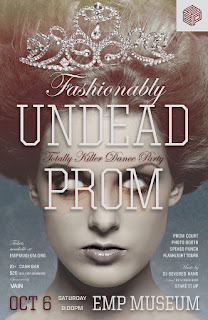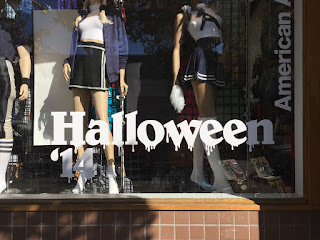Examples of Exhibiton photos that use photography:
What caught my eye about this exhibition poster is the simplicity of the layout, and the use of negative space around the central image and the small amounts of texts. The use of dull colour in negative space works well in contrast to the bright, vibrant colour of the water in the photograph being used, as it draws your attention directly to the main image. I also enjoy the way that the photograph used in this poster has been cropped into a diamond shape, which makes for a more interesting composition. By using a simple San Serif text against a plain background, the designer has made the text very easy to look at and read.
Unlike the previous poster, the background is actually made up of a photographic rather than placing a photograph on a plain background and creating negative space. This technique works really well, as it makes the poster stand out well and catch the viewer's eye. By using a red text box over the top of a Black and White image, the artist has again been able to create a very eye-catching poster, as the red text box stands out so well against the dull colours of the image in the background.
This poster is very similar to the one above. What particularly caught my eye about this one was the photograph used as the background, because it is very bright, colourful and vibrant, which creates a rather positive atmosphere for the viewer. The text box used in this poster is a much darker colour than the red one used in the previous example, which doesn't stand out as well, but still makes the text very easy to read and understand. The photograph used is also very soft, as the it is only the carousel in the background that has been left in sharp focus, compared to the out of focus tree and lights on the right hand side of the foreground. The rule of thirds could easily be applied to this image, as the the text box is on the left of the poster, and the out of focus part of the image is on the right, whilst the focused part of the image is directly in the centre of the poster.
Like the first example, this poster uses a lot of negative space. The image in question has been cut out like a silhouette and stuck against a plain white background, which makes it stand out more. The bright colours used in the main photograph are also very eye-catching and bright in contrast to the dull background. The use of this dull background however makes the black text above the image very easy to read. The artist seems to have used a very central composition in this image, which means drives the viewer's attention directly down the centre of the poster, to read/look at each item in turn.
This poster caught my eye because the artist has actually used multiple photographs in their design, unlike the other examples that I have looked at, which only use one main image. By using dark images, all with similar tones and colours, against a plain white background, the artist has been able to make each individual image stand out against the page. The composition of this poster is also rather eye-catching, as the use of a grid makes the viewer look at each image in turn without losing interest, so they focus all of their attention on each image.
































